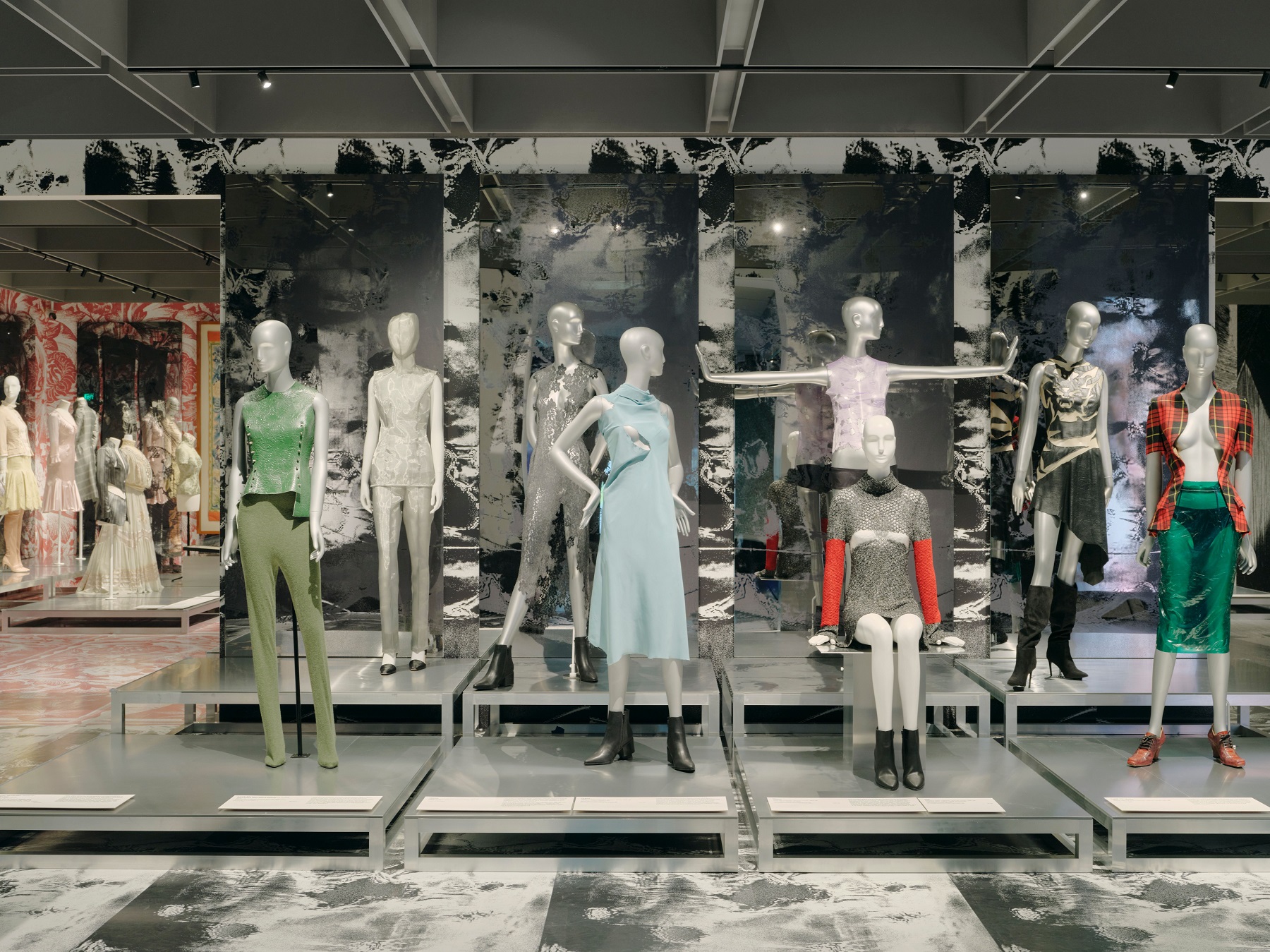Alexander McQueen (1969 – 2010), one of the most significant fashion designers of the late twentieth-century, was lauded for his conceptual and technical virtuosity. McQueen’s critically acclaimed collections synthesised his proficiency in tailoring and dressmaking with encyclopaedic and autobiographical visual references that spanned time, geography, media, and technology.
The extraordinary and stunning exhibition showcases masterpieces from one of the greatest designers of our time.
Much like the creations themselves, no two spaces are the same, curated beautifully to fit the world that McQueen created through his designs.
One can’t help but feels a sense of sheer nostalgia as we walked through the timeline of this extraordinary artist.
Organised by the Los Angeles County Museum of Art (LACMA), in partnership with the National Gallery of Victoria (NGV), Alexander McQueen: Mind, Mythos, Muse is the first major Australian exhibition to explore the work of this boundary-pushing fashion designer. Showcasing more than 60 looks drawn from LACMA’s holdings of important works by McQueen, the Melbourne presentation also features more than 50 looks by McQueen from the NGV Collection, as well as key loans from designer Katy England’s personal archive, making this Australian-exclusive presentation especially rich and comprehensive.
Offering an unprecedented insight into the mind of this seminal designer, McQueen’s work is presented alongside more than 80 historical artworks including painting, sculpture, photography, decorative arts and works on paper from the collections of LACMA and NGV, that reveal the myriad reference points that influenced his designs. The juxtaposition of garments and artworks highlights McQueen’s creative process and capacity for storytelling, as well as offering audiences an opportunity to gain a deeper appreciation of his artistic legacy and the nature of inspiration.
Alexander McQueen features examples from some of the designer’s earliest and most acclaimed collections, including the controversial Highland Rape (autumn-winter 1995–1996) and poetic The Widows of Culloden (autumn-winter 2006–2007), which both take inspiration from McQueen’s ancestry and Scottish history. In-depth presentations of Deliverance (spring-summer 2004) as well as his final complete collection, Plato’s Atlantis (spring-summer 2010), are also a highlight. The exhibition also features commissioned headpieces by Los Angeles-based artist and designer Michael Schmidt, as well as garments originally owned by McQueen’s muses Isabella Blow and Annabelle Neilson.
The Melbourne exhibition emphasises the contribution of philanthropist Krystyna Campbell-Pretty AM and Family, whose generosity has transformed the NGV’s Fashion and Textiles collection and made its holdings of designs by McQueen the largest and most significant in Australia. The LACMA exhibition also highlights a substantial gift from Los Angeles -based collector Regina J. Drucker that has greatly enhanced LACMA’s collection of works by McQueen, which is the largest held by a public institution in North America.
Alexander McQueen will be launched on Saturday 10 December 2022 with the popular event, the NGV Gala. A celebration of art, fashion, fine food, and wine, the NGV Gala was inaugurated in 2017 and has since become an anticipated event on Melbourne’s cultural calendar. Strictly limited tickets are available from Friday 20 May.
Michael Govan, LACMA CEO and Wallis Annenberg Director, said: ‘Juxtaposing Alexander McQueen’s designs with artworks in a wide range of media opens up a new perspective on his process and artistic legacy. We are thrilled to share this groundbreaking exhibition with Australian audiences, and we are grateful to Regina J. Drucker for her incredible generosity in making this presentation possible.’
Tony Ellwood AM, Director, NGV, said: ‘Alexander McQueen is beloved for his boundary-pushing and highly conceptual designs that set him apart from his contemporaries. With meticulous craftmanship and an intellectual rigour seldom seen on the runways before or since, he created a new vocabulary for fashion design that still resonates today. Comprising more than 120 works, this showstopping exhibition unites the collections of LACMA and the NGV for the very first time, and celebrates the timeless work of one of the true icons of late twentieth century fashion.’
Minister for Creative Industries, Steve Dimopoulos, said: ‘This standout exhibition is an explosion of fashion, art and creativity, offering Victorians a rare chance to get up close to many of Alexander McQueen’s bold and influential designs. We’re backing NGV’s blockbuster Summer Series to deliver another must see exhibition that will draw thousands of visitors to the state, offering another highlight in a jam-packed calendar of attractions this summer that will boost local businesses and jobs.’
The exhibition explores McQueen’s oeuvre across four themes. Mythos explores three collections inspired by mythological and religious belief systems, incorporating visual references to diverse cultures as well as art-historical movements. Untitled (Angels’ and Demon’s) looked to the art of the Dark Ages ‘to find light and beauty’, borrowing from Italian and northern Renaissance art, while Neptune saw the designer drawing upon imagery from the Classical period. While these collections put McQueen’s impressive breadth of artistic source material on display, they also highlight a practice of external inspiration-seeking that characterized fashion design during his career.
The second section, Fashioned Narratives, considers McQueen’s penchant for worldbuilding, highlighting four collections that tell original stories or reimagine past events. Rooted in McQueen’s personal history, these romanticised narrative collections explore themes of power, persecution, violence and survival. In Memory of Elizabeth How, Salem, 1692 (autumn-winter 2007–08) traced McQueen’s genealogy to colonial Massachusetts to honour a relative, one of the first women to be executed in the Salem witch trials, while The Widows of Culloden (autumn-winter 2006–07) reflected on McQueen’s heritage and British violence in Scotland during the 1746 Battle of Culloden. Blending British and Indian history with punk references, The Girl Who Lived in the Tree (autumn-winter 2008) centred on a fairy-tale narrative written by his friend and muse Annabelle Neilson inspired by an ancient elm in the garden of McQueen’s Sussex home.
Evolution and Existence examines McQueen’s fascination with life cycles and the human condition. The designer’s considerations of nature, evolution and death resulted in collections that explored life’s inherent fragility – and found hope in its regeneration. The Horn of Plenty (autumn-winter 2009–10) critiqued mass consumerism, which McQueen countered by recycling famous silhouettes from fashion history and his own archive. The Dance of the Twisted Bull (spring-summer 2002) portrayed bullfighting as a metaphor for brutality and beauty, while Deliverance (spring-summer 2004) presented an allegorical “dance to the death” inspired by the film They Shoot Horses, Don’t They? The designer’s final completed collection, Plato’s Atlantis (spring-summer 2010), imagined a world consumed by the ocean, the place where life originated – and, as McQueen suggested, would continue.
Technique and Innovation demonstrates McQueen’s masterful abilities in garment construction and approach to the female form across his career through a series of dedicated displays focusing on tailoring, dressmaking, deconstruction and the notion of a dangerous body. By juxtaposing early and later career works, this section highlights McQueen’s technical agility – from works indebted to his formative years as an apprentice tailor on Savile Row to those that show his capacity for fluid drapery – as well as his interest in Western costume history and use of unique surface treatments.
Within this section, Dangerous bodies features some of the earliest McQueen works in the exhibition and the NGV Collection, including works from Banshee (autumn-winter 1994), Highland rape (autumn-winter 1995–1996) and The Hunger (spring-summer 1996), which speak to his penchant for savage cutting, and ideas of eroticism and empowerment. McQueen’s use of inventive fabrics, surface treatments, and emerging technologies, such as laser-cutting and digital printing, will also feature and highlights the designer’s innovative design approach.
Also featured in the exhibition is extensive video footage from McQueen’s iconic runway presentations; from his 1992 graduate collection, Jack the Ripper Stalks his Victims to the confrontational Voss, spring–summer 2001, to the ground-breaking Plato’s Atlantis, spring–summer 2010. These are complemented by large scale photographic prints captured by British photographer Robert Fairer, who spent over sixteen years working with McQueen and who specialises in the art of backstage photography.
Alexander McQueen: Mind, Mythos, Muse will be on display from 11 December 2022 – 16 April 2023 at NGV International, St Kilda Road, Melbourne. Tickets available here. The exhibition opening will coincide with the NGV Gala, an annual event on Saturday 10 December 2022. Tickets and information are available here.
















